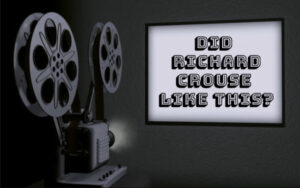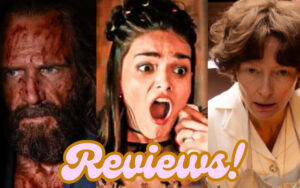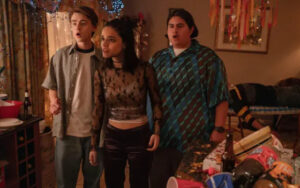CTV ATLANTIC: RICHARD AND TODD BATTIS ON NEW MOVIES IN THEATRES!
 I join CTV Atlantic anchor Todd Battis to talk about the almost epic “The Return,” the apocalyptic musical “The End” and the nostalgic disaster flick “Y2K.”
I join CTV Atlantic anchor Todd Battis to talk about the almost epic “The Return,” the apocalyptic musical “The End” and the nostalgic disaster flick “Y2K.”
Watch the whole thing HERE!
 I join CTV Atlantic anchor Todd Battis to talk about the almost epic “The Return,” the apocalyptic musical “The End” and the nostalgic disaster flick “Y2K.”
I join CTV Atlantic anchor Todd Battis to talk about the almost epic “The Return,” the apocalyptic musical “The End” and the nostalgic disaster flick “Y2K.”
Watch the whole thing HERE!
 I sit in with hosts Jim Richards and Deb Hutton on NewsTalk 1010 to play the game “Did Richard Crouse Like This?” This week we talk about the almost epic “The Return,” the apocalyptic musical “The End” and the nostalgic disaster flick “Y2K.”
I sit in with hosts Jim Richards and Deb Hutton on NewsTalk 1010 to play the game “Did Richard Crouse Like This?” This week we talk about the almost epic “The Return,” the apocalyptic musical “The End” and the nostalgic disaster flick “Y2K.”
Listen to the whole thing HERE!
 I sit in on the CFRA Ottawa morning show with guest host Andrew Pinsent to talk the new movies coming to theatres including the almost epic “The Return,” the apocalyptic musical “The End” and the nostalgic disaster flick “Y2K.”
I sit in on the CFRA Ottawa morning show with guest host Andrew Pinsent to talk the new movies coming to theatres including the almost epic “The Return,” the apocalyptic musical “The End” and the nostalgic disaster flick “Y2K.”
Listen to the whole thing HERE!
 Fast reviews for busy people! Watch as I review three movies in less time than it takes to do a high five! Have a look as I race against the clock to tell you about almost epic “The Return,” the apocalyptic musical “The End” and the nostalgic disaster flick “Y2K.”
Fast reviews for busy people! Watch as I review three movies in less time than it takes to do a high five! Have a look as I race against the clock to tell you about almost epic “The Return,” the apocalyptic musical “The End” and the nostalgic disaster flick “Y2K.”
Watch the whole thing HERE!
 SYNOPSIS: “Y2K,” a new disaster comedy now playing in theatres, imagines what could have happened if predictions of a technological armageddon came true as the world greeted the new millennium on New Year’s Eve 1999. “It’s goodbye human race,” says Laura (Rachel Zegler).
SYNOPSIS: “Y2K,” a new disaster comedy now playing in theatres, imagines what could have happened if predictions of a technological armageddon came true as the world greeted the new millennium on New Year’s Eve 1999. “It’s goodbye human race,” says Laura (Rachel Zegler).
CAST: Jaeden Martell, Julian Dennison, Rachel Zegler, Fred Durst, and Alicia Silverstone. Directed by Kyle Mooney.
REVIEW: Part teen coming-of-age comedy, part apocalyptic disaster flick and part affectionate 1990s time capsule, “Y2K” takes a one joke premise and stretches it as thin as a sheet of foolscap to reflect on our relationship with technology.
In this world, the machines are tired of being conduits for hate and pornography and attempt a coup. “Cell phones. E-mail,” a snarky computer avatar tells computer hacker Laura. “You’re already our slaves.”
Director Kyle Mooney, who also co-wrote the script and co-stars as stoner video store clerk Garrett, hit most of the right notes in creating the world of “Y2K.” As a teen buddy comedy, he gets it right with fun period details and the casting of Jaeden Martell and Julian Dennison as nerdy best friends, the lovelorn Eli and the boisterous Danny. They are classic teen movie outsiders who step up when tested, and when they are on screen together, they’re prove to be a winning combo.
It’s when the digital revolution really gets underway that “Y2K” begins to wobble. The idea of the world’s computers bonding together as towering, killer robots, cobbled together from all manner of electronics, is cool and their first attack (which includes a homicidal Tamagotchi), just minutes into the new year, is chaotic and fun. The practical effects and frantic pacing feel like a throwback to 90s teen films, and for a time, the jokey idea has some spark.
As the teen story of survival continues into the last forty-five minutes, however, the characters aren’t up to the task of keeping us engaged with the material and “Y2K” runs out of juice.
“The Hunger Games: The Ballad of Songbirds and Snakes,” is an origin story, because what good is a franchise if it doesn’t splinter off in an origin story or two? The prequel set 64 years before the events of the successful Jennifer Lawrence franchise, is a big and bold movie about the future ruler of Panem that feels as though it may have worked better as a miniseries.
The new film centers on Coriolanus Snow (Tom Blyth), scion of the once powerful Snow family.
Orphaned during a civil war that divided the nation of Panem into a wealthy Capitol city, where everyone seems to dress like the keyboard player of Spandau Ballet circa 1983, surrounded by twelve poverty-stricken Rocky Mountain districts, where everyone speaks like a Dolly Parton impersonator.
Coriolanus is living hand-to-mouth with his grandmother (Fionnula Flanagan) and cousin Tigris (Hunter Schafer), trying hard to keep up appearances at his fancy school, and hoping to win an academic scholarship. “Look at you,” says Casca Highbottom (Peter Dinklage), Academy dean and creator of the Hunger Games. “Your makeshift shirt and your too tight shoes, trying desperately to fit in, when I know you Snows don’t have a pot to piss in.”
Despite his hardships, A-student Coriolanus is a shoo-in to win the scholarship until Highbottom announces that the bursary will no longer be award for grades. As part of the upcoming Hunger Games, a televised gladiatorial death-match that pits kids, or “tributes,” from the districts against one another, Coriolanus will have to mentor Lucy Gray Baird (Rachel Zegler), a tribute from the impoverished District 12, given to bursting into rebel showtunes. If she survives the game under his leadership, he’ll get his scholarship and an entrée into the life of his dreams.
What begins as a battle for life and death, becomes a larger story of good vs. evil, of love and destiny, of opportunity and choice.
“The Hunger Games: The Ballad of Songbirds and Snakes” is a big handsome movie with a lot on its mind. Fans of the series will know that Snow goes on to become a villain, an autocratic ruler with a sadistic side. This is how he got there, from outcast to insider, from protagonist to antagonist. The detailed descent into evil is born from his instinct for self-preservation that overrides whatever righteousness once resided in his soul.
Fans may enjoy the trip back top Panem, but “The Ballad of Songbirds and Snakes” has a different feel from the originals. The first set of films were very much about Katniss Everdeen’s (who does not appear here) decency as a galvanizing symbol of rebellion against oppression.
This is the anti-hero’s journey, and, as such, it’s darker and not as action packed.
It’s a character study, divided into three sections and stretched to an over-long two-hours-and-forty-minutes. Each episode covers an aspect of the story, but, particularly as we get to the last section, the storytelling feels disjointed, rushed, as if there is too much story for one movie. The world building is interesting, and Blyth is suitably icy, but as we’re ushered through the episodic tale, it feels as if this could have used a different approach to fully flesh out the story. A mini-series might allow the time the story needs to feel fully realized.
“The Hunger Games: The Ballad of Songbirds and Snakes” is a different beast than its predecessors. Lucy Gray’s musical numbers—it sometimes feels like “Hunger Games” done by theatre kids—add a new dimension, and the tone is different, but it is the study of the banality of evil that really sets it apart from what came before.
In 2019’s “Shazam!,” teenager Billy Batson’s (Asher Angel) life took a metaphysical turn when an ancient wizard Djimon Hounsou), protector of the realms from the Seven Deadly Sins and keeper of the Rock of Eternity, plucked him from obscurity to transform into superhero Shazam, the adult champion of the world.
In the new film, “Shazam!: Fury of the Gods,” set two years after the events of the first movie, Billy still grapples with his superhero alter ego (Zachary Levi). “I’m an idiot,” he says. “I don’t deserve these powers, if I’m being honest. Like, what am I even contributing? There’s already a superhero with a red suit with a lightening bolt on it. Aquaman is literally huge, and he’s so manly. And Batman, he’s so cool. I feel like a fraud.”
This new adventure sees Batson, and his foster siblings, who also transform into superheroes by saying the magic word “Shazam!,” pitted against their most ferocious foe yet, the Daughters of Atlas.
“We are at war,” says Hespera (Helen Mirren). “We will annihilate everything. The champions of this realm can do nothing to stop us.”
The Daughters of Atlas want to strip the Shazam gang of their powers but as they do that the fate of the world hangs in the balance. “You are very menacing,” Shazam says to Hespera. “I just want you to know that.”
At its heart “Shazam!: Fury of the Gods” is a coming-of-age story. Billy begins the movie insecure, a victim of imposter syndrome. Unfortunately, as his confidence grows, so does the movie’s tendency to clutter up the screen with busy CGI, heaping helpings of mythology and not-so-subtle product placement. (They even manage to find a way to work in the Skittles “taste the rainbow” slogan.)
The best elements of the first film are present. The focus on family—finding your logical, if not biological family—the humour and Levy’s manchild performance as the title character, provide the film’s heart but the effort to make the sequel bigger-and-better overshadow the more organic, pleasing parts of the story.
It is a blast to see Helen Mirren channel her inner Shakespearean villain as Hespera, and some of the Ray Harryhausen-inspired creatures have a cool, “Famous Monsters of Filmland” retro appeal but, in general, when it comes to “Shazam!: Fury of the Gods,” bigger is not better.
 Richard joins CRTV National News reporter John Vennavally-Rao to discuss “West Side Story” star Rachel Zegler’s invitation to present at the Academy Awards after an initial snub.
Richard joins CRTV National News reporter John Vennavally-Rao to discuss “West Side Story” star Rachel Zegler’s invitation to present at the Academy Awards after an initial snub.
Watch the whole thing HERE!
The list of films Hollywood considers sacred and untouchable is a short one. Only a bugger for punishment would attempt a redo of “The Godfather.” And imagine the jeers that would accompany the announcement of a reimagined “Casablanca” or “Do the Right Thing.”
Until recently I would have put “West Side Story,” the classic 1961 musical that won ten Academy Awards, in the top five of films on the No Go list. But just as that show riffed on “Romeo and Juliet,” a classic if there ever was one, Steven Spielberg takes another look at a memorable movie the TCM crowd considers untouchable.
Set in 1950s New York City, the story of love at first sight is plays out against a backdrop of the gentrification of the Upper West Side, a then blue-collar neighborhood. Two gangs, the Puerto Rican Sharks and the Jets, the “Last of the Can’t Make It Caucasians,” run the streets as the NYC Department of Slum Clearance chop up their home turf. The only thing they have in common is a “womb to tomb” membership motto.
Into this comes Tony and Maria (Ansel Elgort and newcomer Rachel Zegler), star-crossed lovers whose infatuation causes friction between the gangs. “You’re going to start World War III,” says Anita (Ariana DeBose).
Tony’s best friend Riff (Mike Faist) runs the nativist white Jets—“Everything is being taken over by people I don’t like,” he sneers.—while Maria’s brother Bernardo (David Alvarez) leads the Sharks.
Tony is on parole for almost beating a boy to death in a rumble, but has turned over a new leaf. “I want to unlike myself,” he says, “because I was headed to the sewer.” He also puts to rest the notion that “once you’re a Jet, you’re a Jet all the way.” He wants out of that life, but most of all, he wants Maria.
As Riff and Bernardo plan a rumble to viciously work out their differences, Maria begs Tony to put an end to the violence. “We can’t pretend what we do didn’t cause this trouble,” she says. Tony intervenes, but the situation quickly spirals out of control.
Steven Spielberg’s take on “West Side Story” feels rooted in the tradition of movie musicals but vibrates with current themes. The social mindfulness that was revolutionary for musical theatre in the 1950s Broadway run is present and expanded on. Tony Kushner’s script offers context and backstories for underdeveloped characters and plays on hot button themes of racial animus, poverty and violence.
Most of all, however, it’s about love.
It’s love that causes all the trouble but also gives the movie its beating heart. As the couple in question Elgort and Zegler are appealing, wide-eyed romantic figures. Zegler is a convincing swirl of determination and innocence, with a beautiful voice. Elgort can wrap his mouth around Stephen Sondheim’s lovely lyrics—”Maria, say it loud and there’s music playing. Say it soft and it’s almost like praying”—but doesn’t shine as bright as some of his co-stars.
As Bernardo, Alvarez brings the menace, smooth charm and athletic dance moves to steal his scenes. Faist also impresses as hardheaded gang leader Riff. DeBose gives a high stepping performance as Bernardo’s girlfriend Anita, a role that grows more poignant in the movie’s third act.
But it’s a returning cast member from the 1961 film who gives the movie its soul.
Rita Moreno won an Oscar for playing Anita in the original. Here she plays drug mart operator Valentina. Kushner expands the role, making the character the conscience of the neighborhood. She is luminous in the part, and, in a major departure from the 1961 film, does a solo rendition of “Somewhere,” a song of hope usually sung by the romantic leads. Here it is devastating, played as song of longing and loss. If my goosebumps voted for the Academy Awards, Moreno would have another statue to put on her shelf.
“West Side Story” is Spielberg’s most compelling film in years. It reinvents, reimagines and recontextualizes a classic story with energy, respect and lots of finger snapping.